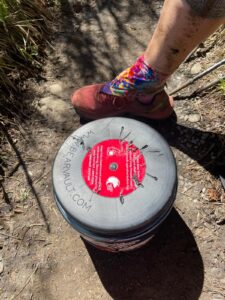WHAT DOES BEING “BEAR AWARE” MEAN?
It’s that time of year again! Here in the Appalachian Mountains, the wildflowers are blossoming, the baren branches are finally leafing out, and everything has that exquisite, fresh green glow. It also means that our indigenous black bears are awake and active, roaming, often with cubs, looking for their next meal.
I saw my first bear in the Smokies several weeks ago. It was a small yearling, solid black in color, loping up the trail ahead of me. I never saw him again, but for a moment in time, we just paused and looked at each other. It felt like a genuinely enchanted gift.
It was also a reminder that we need to be mindful of our food, trash, and other “smellables” when living outdoors. Whether your adventure is deep in the backcountry or a frontcountry campground, when bears gain access to human food, they lose their fear of humans and can become aggressive and dangerous. Unfortunately, when aggressive and nuisance bears that have become habituated to human food threaten or injure people, they are euthanized. Whether a bear is fed intentionally or unintentionally, a fed bear is a dead bear.
In our culture, black bears are often portrayed as cute and cuddly creatures, even depicted as lovable cartoon characters. (Think Yogi, Paddington, Winnie the Pooh, and Smokey…) Still, they are wild animals that must forage for the foods that nature intended for them. Bear encounters are on the rise in many areas. The warming weather drives nature lovers outside, pursuing hiking and camping adventures on trails such as the Appalachian Trail (AT). Much of the AT is prime black bear habitat. Learning more about bear behavior and striving to become more aware of our impact on our environment can ensure safe and enjoyable outdoor ventures.
The following is an unedited excerpt from my soon-to-be-published book, WildWood Magic: A Guide to Backpacking as a Sacred Practice, about bear awareness, safety, and ways to properly store food in the backcountry. I dedicate the following section to all those who enjoy walking in nature and safely spending nights outdoors.
Bears can thrive in their natural environment, eating their own food and maintaining balance by keeping a healthy distance from humans. Humans are wholly responsible for all negative wildlife encounters. We must respect all nature, hold ourselves accountable, and commit to being diligent Keepers of the Land.
Namaste
CRITTER SAFETY: HOW TO PROPERLY STORE FOOD AND OTHER SMELLABLES
When backpacking in areas where bears and other wildlife are present, it is essential to keep your food and other smellables safe and minimize potential interactions. In the backcountry, practicing proper food storage and maintaining a clean camp will protect the bears, you, and other hikers. Properly store all food, trash, and scented items (such as cooking gear, eating utensils, hand sanitizer, insect spray, sunscreen, and toiletries) while you are away from your camp and at night by using the best technique for the area where you are camping. Never sleep with your food! Not only is this practice extremely dangerous for humans and bears, but it is also prohibited in most areas.
BEAR-RESISTANT BAGS AND CANISTERS
Because of past issues, many areas have adopted specific food storage requirements. Hard-sided bear-resistant food canisters are now required in many places. If you are backpacking in bear country, it is often recommended that you use a “bear canister.” Bear canisters are made of hard, durable plastic and, depending on size, have a capacity of approximately 5 to 15 liters and weigh anywhere from 1 ½ pounds to upwards of 4 pounds or more. Also, never tie a rope around the canister, as this only provides a convenient handle for bears to haul it away.
Bear-resistant sacks are strong (yet rarely waterproof) bags made from durable, lightweight materials, such as Kevlar, specifically designed to hang and protect food. Others are made to repel rodents, but many don’t cinch tight enough to prevent a tiny mouse from entering at the closure.
Bear-resistant bags and canisters are designed to deter bears and other wildlife from gaining access to your food. They help minimize human-wildlife conflicts and promote the safety of both animals and backpackers. By securely storing your food in bear-resistant containers, you can have peace of mind knowing that food and smellables are protected, allowing you to relax and enjoy your outdoor experience. More and more, the use of bear-resistant canisters is now mandated by trail management authorities.
However, bear-resistant canisters are heavier and bulkier than traditional “stuff sack” food bags. Carrying them can add significant weight to your backpack (empty!), affecting your overall load and limiting pack space. They have limited storage capacity, which can be challenging when packing for longer trips. They can, however, be used as a handy stool (as long as you put them on level ground!)
 All bear-resistant food storage options should be used in conjunction with other critter safety practices, such as proper food and waste handling, cooking location selection, and diligent camp cleanup. Always cook and store your food at least 200’ (about 70 paces) from where you sleep at night. Clean up any spilled food or dropped crumbs. And, of course, pack out all your trash, including biodegradable waste such as orange peels, apple cores, pistachio shells, and all wipes… yes, even the ones marked “compostable.”
All bear-resistant food storage options should be used in conjunction with other critter safety practices, such as proper food and waste handling, cooking location selection, and diligent camp cleanup. Always cook and store your food at least 200’ (about 70 paces) from where you sleep at night. Clean up any spilled food or dropped crumbs. And, of course, pack out all your trash, including biodegradable waste such as orange peels, apple cores, pistachio shells, and all wipes… yes, even the ones marked “compostable.”
BEAR CABLE SYSTEMS
Backcountry hikers in some places, such as the Great Smoky Mountains National Park (GSMNP), require hikers to hang food, trash, and scented items from food storage cables. There are hooks for food bags at one end and color-coded carabiners on the other side that attach to an eyebolt screwed into a tree. In the GSMNP, you are required to hang your bear canister in your pack on the cables found at each campsite and shelter.
BEAR BOXES
Some campsites along the AT are now equipped with bear-resistant storage boxes. These bearproof boxes utilize various locking mechanisms that are easy for humans to operate but impossible for bears to access. These boxes are convenient and straightforward to use but have also led to people leaving trash behind. Please Leave No Trace and pack out everything you bring with you!
THROWING A BEAR BAG LINE
If there are no cables or bear boxes, you must hang your food and other smellables in a bag from a tree branch with a cord. Besides weariness at the end of a long day of hiking, the biggest challenge of hanging a bear line is often the absence of trees with suitable branches. An appropriate tree will have a branch strong enough to hold the weight without damaging the tree and be an adequate distance from the trunk and the ground. Although it can be tricky at times, it is a skill worthy of practice and mastering.
HOW TO MAKE A BEAR BAG
Begin by choosing a waterproof, seam-sealed stuff sack (preferably with a roll-top closure) bag large enough (typically 13 Liters or more) to hold all food, trash, cooking gear, and toiletries. Check all your pockets for trash and your backpack’s contents to ensure you collect everything with an interesting smell (not just what is considered food smells, such as scented lip balm, hand sanitizer, insect repellent, sunscreen, etc.).
Securely attach one end of 50’ of durable, lightweight nylon rope or paracord to a small bag or pouch, in which you can place a small palm-sized rock that makes it weighted and, therefore, easier to throw over a branch. Stand a safe distance away from the intended target and throw the bag with the rock over the branch. You can attach your food bag using a small carabiner to hoist the bag up by the rope. It has been common practice to secure the rope to a nearby tree, tying it off with a knot that won’t slip. However, bears are intelligent and have learned to defeat this traditional method by swiping at the taut cord.
The most reliable technique is to use a proper “PCT-style” bear line hang. An excellent video demonstrates how to properly throw a “PCT-style bear hang,” courtesy of the Appalachian Trail Conservancy (ATC). Watch it here.
For a basic one-tree bear bag hang, look around for a suitable tree at least 200 feet away from your campsite. Select a sturdy branch that can support the weight of the bag and is at least 15’ from the ground and 6’ away from the trunk of the tree. Sometimes, it is a practice in patience searching for a suitable tree that may be located up or down the trail and possibly a good distance away from camp. Be mindful when stepping off the trail, and mentally note how many paces you are away from a landmark, sign, or the campsite. This ensures you find your food bag easily, protects fragile flora growing alongside the trail, and could prevent you from stepping on anything that could bite, sting, or give you a skin rash.
BECOME A PRO AT HANGING A BEAR BAG!
Here are some things to remember when removing your line from its storage bag. First, pull the whole length of the line out, coiling it loosely next to you on the ground to ensure there are no knots or tangles. When you throw it, step on the other end of the cord. If the other end is not secured, the whole thing could get stuck up in a tree limb with no way to retrieve it. If there are knots or tangles when you throw it, it could pick up sticks or other debris, altering the trajectory of your perfect bear bag line throw. Use your vivid imagination to visualize where you want the bear line to go. See yourself become adept at finding ideal places for a bear bag line and perfecting your throw.
Check the regulations of the area you are visiting and follow any recommendations provided by wildlife management agencies to ensure the utmost safety for you and all wildlife. Using approved food storage methods ensures you contribute to the area’s conservation efforts and help minimize human-wildlife conflicts.
EXPLORING A SIDE TRAIL TO TAKE IN A VIEW? DON’T STASH YOUR GEAR; TAKE IT WITH YOU.
Never leave your backpack unattended with food, trash, and other smellables, even for a moment. I learned this the hard way many years ago by dropping my backpack at my campsite and jumping into a river a mere 50’ away. Unbeknownst to me, this area was home to an aggressive, human-food-habituated bear. I learned many things on that backpacking trip. It is the only time my food has been taken by a bear. My wild foraging skills were put to the test! Thankfully, it was berry season, and I only had one more day of hiking before returning to my vehicle. I reported the incident and later learned this bear was killed… for no other reason than humans being careless with their food and garbage.
CHAPTER XX: WILD CREATURES AND BITEY THINGS
WALKING IN BEAR COUNTRY:
Bears are truly remarkable creatures. Seeing one can be a magical experience when viewed from an appropriate distance and with thoughtful consideration. When hiking in bear country, some precautions need to be taken so you can enjoy the wildness of nature with confidence and without fear. Bears are typically scared of humans and scurry off at the slightest hint of your presence. However, there are occasions when they can be startled, curious, or defensive and act in less predictable ways.
The type of bears you may encounter will largely depend on your location. The American black bear has the most extensive range of all the bears and is the most commonly seen. They inhabit areas as far north as Canada and south as far as Mexico. They are common in the east and the west from the Rockies to Alaska.
Like grizzlies, black bears can range in color from light brown to black, although they tend to be almost always black in the eastern United States. Black bears have ears that stand more erect, have an overall more pointed face, and are missing the indicative shoulder hump that grizzly, brown bears, and polar bears have. Grizzly bears are most commonly found in Alaska, western Canada, Wyoming, Montana, Idaho, and Washington.
You can avoid startling bears by frequently making noise, singing, talking, or clapping your hands while you walk. Bears are most active at dawn and dusk. Bears are more likely to become aggressive when you are between a mama bear and her cubs or near a perceived food source.
WHAT DO I DO WHEN I SEE A BEAR?
Never run away because this can trigger an animal’s instinct to give chase. Slowly back away and give all bears a wide berth. While most of the time they will immediately scamper away, you will occasionally encounter a more curious black bear. If it moves into your campsite and is hesitant to flee, throwing rocks may be an appropriate deterrent.
In a black bear encounter, avoid direct eye contact, make yourself look as large as possible, yell loudly, bang your hiking poles together, or whatever is handy to make a lot of noise. The number of black bear-related deaths (less than one death per year on average) is minute compared to the millions of people walking around in bear territory every year.
In grizzly country, it is recommended that you carry bear spray. It is effective at 15- 30,’ depending on the brand, and will discharge a continuous stream of concentrated capsaicin spray (the component that makes the pepper spray hot and spicy). It is crucial to know when and how to use it properly, being careful to remain upwind of the stream.
In a grizzly bear encounter, do not run, avoid eye contact, and back up slowly as long as the bear is not approaching you. If a grizzly bear begins to charge, deploy bear spray only when you are within range. It is impossible to outrun a bear, so stand your ground and wave your arms around. If you are attacked, curl up in a ball or lie flat on the ground with your legs spread apart so the bear cannot roll you over. Remain as calm as possible and try not to panic. Play dead for as long as the bear is in the vicinity. Carrying a gun in the backcountry is not recommended. Besides being heavy, bear spray has been proven to be much more effective than bullets in deterring grizzly bear attacks.

